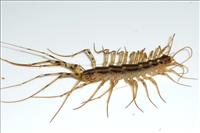
Caption: House Centipede
Photo by: S. Allen
|
|
House centipede
(revision date: 7/14/2015)
Use Integrated Pest Management (IPM) for successful pest management.
Biology
The house centipede (Scutigera coleoptrata) is a slender, flattened, many-segmented arthropod approximately 1 to 1 1/2 inches long. It can be found throughout the United States, both in and outdoors in warmer areas, and primarily indoors in colder regions. This centipede is grayish-yellow in color with three dark stripes running along its back. Adults have fifteen pairs of long, fragile legs. The long, delicate antennae and the last pair of legs are both longer than the body. Newly hatched nymphs have four pairs of legs, with additional pairs being added with each molt. House centipedes are quick, agile hunters of spiders and insects, including flies, cockroaches, moths, and many other insects found indoors. They are usually active at night and run very quickly, holding their body up on its long legs. House centipedes prefer damp areas; frequently they are found in basements, bathrooms, closets, or potted plants. As with all centipedes, house centipedes have strong mouthparts with large jaws. They may inflict a painful bite if handled. While they can be considered beneficial since they are predators and aid in control of indoor insect pests, house centipedes usually alarm homeowners and can be a nuisance in the home.
|
